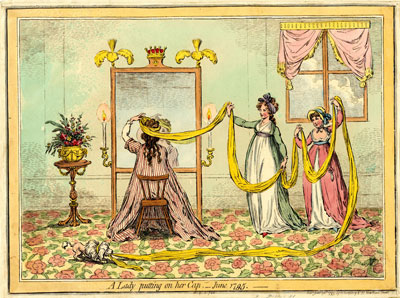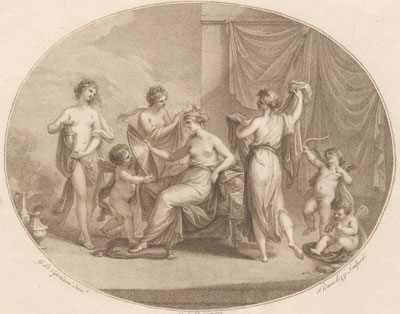A Lady Putting on her Cap
This is one of nearly a dozen prints by Gillray devoted to satirizing the fashions of the British beau monde in 1795/96. They include Characters in High Life (June 20, 1795) Ladies Dress As It Soon Will Be (January 20, 1796) and The Fashionable Mamma, or The Covenience of Modern Dress (February 15, 1796.

© Trustees of the British Museum
This print makes fun of the lengths of fabric required to create the turban-like caps which were all the rage at the time, in this case requiring two attendants to hold up the wrap and still trailing yards of it as a plaything for an interested dog. Judging from the ads in the newspapers at the time, the fabric was usually muslin or crepe cut specifically for turbans and sold by the yard. And when the head was fully wrapped, the cap was, as the London St.James's Chronicle describes, "ornamented by "very high plumes of feathers." (January 17, 1795,Pg. 4.) which one can see in numerous other Gillray prints.
Like most of Gillray's fashion prints, however, A Lady Putting on her Cap is not only a satire directed at turban caps. The woman gazing into the mirror has been reliably identified as Lady Jersey by the Earl's Coronet atop the mirror (her huband was the 4th Earl of Jersey) and by the triple plumed ornaments on either side alluding to the three ostrich feathers which comprise the heraldic badge of the Prince of Wales. (She was his mistress.)
We know Lady Jersey was familiar with the style because, in her role as Lady of Bedchamber, she was sent to meet the Prince's fiancée when she arrived in England with a change of clothes appropriate to the next stage of her visit.
Lady JERSEY did not arrive at the Governor's till an hour after the Princess had landed; and soon after, they both retired into an adjoining room, and the dress of the Princess was changed, from a muslin gown and blue sattin petticoat, with a black beaver hat, and blue and black feathers, for a white sattin gown, and very elegant turban cap of sattin, trimmed with crape, and ornamented with white feathers, which were brought from town by Lady Jersey.
London Times, April 06, 1795,Pg. 2,
The presence of attendants in the print holding festoons of fabric as Lady Jersey gazes into the mirror may also suggest a parody of the popular classical motif of Venus Attired by the Graces.

Detail of Venus Attired by the Graces
[May 1st, 1785]
© Yale Center for British Art, Paul Mellon Collection
In spite of the Prince's marriage to Mrs. Fitzherbert and his engagement with Lady Caroline of Brunswick, Lady Jersey was certainly, at this time, the Prince's preeminent goddess of love.
Sources and Reading
- Commentary from the British Museum on A Lady Putting on her Cap.
- "Turban," Wikipedia
- "Frances Villiers, Countess of Jersey," Wikipedia
- Thomas Wright and R.H. Evans, Historical and Descriptive Account of the Caricatures of James Gillray #409.
- Thomas Wright and Joseph Grego, The Works of James Gillray, the Caricaturist; With the History of His Life and Times, p. 197.
Comments & Corrections
NOTE: Comments and/or corrections are always appreciated. To make that easier, I have included a form below that you can use. I promise never to share any of the info provided without your express permission.